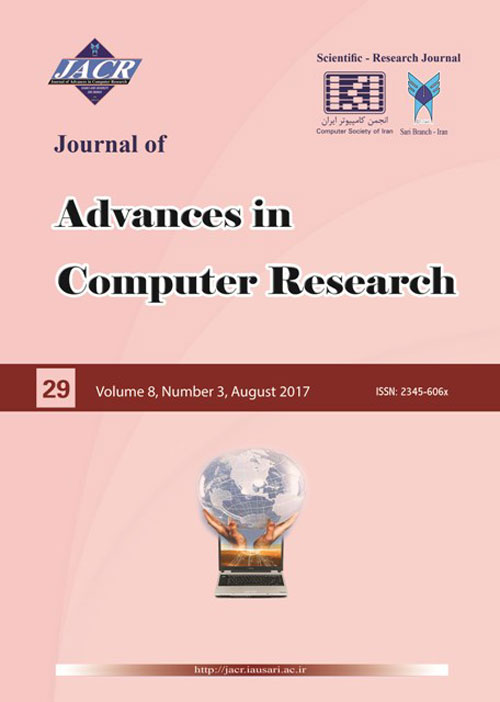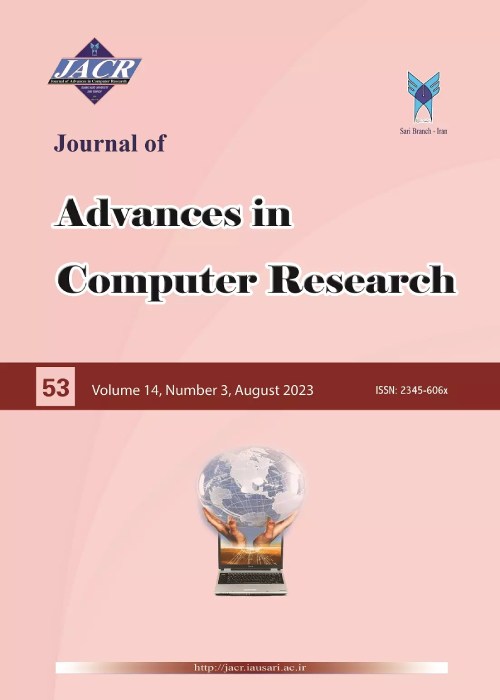فهرست مطالب

Journal of Advances in Computer Research
Volume:8 Issue: 3, Summer 2017
- تاریخ انتشار: 1396/03/26
- تعداد عناوین: 9
-
Pages 1-17Time synchronization protocols, because of having many applications in WSN have been highly regarded. Thesynchronization protocols which act in a distributed way and globally have been more considered. In addition, these algorithms are improving toward becoming secure and having a high applicability. This article presents the proposed algorithm with respect malicious nodes to provide a secure distributed and global time synchronization protocol. Methods of encryption, authentication and hashing dont have a high performance because of high overhead for the synchronization. In this proposed algorithm the previously used methods, like authentication and encryption are not used, but instead the algorithm by applying mechanisms within itself takes into account the corrupted and malicious nodes and does the time synchronization in a distributed way and globally. Finally, the gained results of the simulation in terms of the deviation average of the standard criterion, the time and computational and memory overheads are considered and the applicability of the proposed algorithm will be realized.Keywords: Wireless sensor networks(WSN), time Global synchronization protocols, security, malicious nodes
-
Pages 19-29Wireless sensor networks (WSNs) are composed of many low cost, low power devices with sensing, local processing and wireless communication capabilities. Clustering is a useful topology-management approach to improve lifetime and reduce the energy consumption in wireless sensor networks. In this paper we have proposed a new dynamic clustering method (NDCM) where clusters are created periodically and cluster head (CH) is selected based on threshold function. Unlike the LEACH protocol that clustering are static and cluster head number is fixed in the entire scenario, CHs in our method distributed in Land dimensions and the number of cluster can be dynamically adjusted based on the number of nodes. The simulation was performed in MATLAB software and it was compared with LEACH, LEACH-C, O-LEACH, LEACH-B, M-LEACH, V-LEACH AND W-LEACH algorithms. The simulation results show that proposed method have been reduced energy conservation and enhancement of network lifetime comparing with LEACH algorithm. Coverage of the number of clusters in proposed method is shown too. The results showed that in a test network life of leach protocol was 1100 rounds, whereas network life of proposed method was 3100 rounds.Keywords: LEACH Protocol, Clustering Algorithm, Lifetime, wireless sensor network
-
Pages 31-41Wireless sensor network includes hundreds or even thousands of sensor nodes, which are devices with low energy and often impossible to be replaced or recharged. For this reason, efficient use of energy is one of the major challenges in these networks. One way for increasing energy efficiency in such networks is clustering. Clustering protocols such as LEACH, TEEN, SEP and DEEC randomly select the cluster heads for the clustering process. This causes the cluster heads to be close together, decreasing the efficiency of protocols. For this reason, we proposed a new approach called EBDCH. In this method, when cluster heads are close together, we distribute them based on the energy situation. The proposed approach runs on the clustering protocols. The simulation results show that with the implementation of the proposed method, throughput is increased and network lifetime is improved compared to protocols LEACH, DEEC, SEP and EEHC respectively at 26%,28%,37% and 36%.Keywords: wireless sensor network, Distribution of cluster heads, clustering, Energy efficiency, Network lifetime, EBDCH technique
-
Pages 43-54Feature selection is an important step in most classification problems to select an optimal subset of features to increase the learning accuracy and reduce the computational time. In this paper we proposed a new feature clustering based method to perform feature selection (FFS) in classification problems. The FFS algorithm works in two steps. In the first step, features are divided into clusters by using F-DBSCAN method. A novel F-DBSCAN clustering method used mutual information for measuring dependencies between features. In the second step, the most representative feature is selected from each cluster by a new criterion function. This allows us to consider the possible dependency on the target class and the redundancy between the selected features in each cluster. The experimental results on different datasets show that the proposed algorithm is more effective for feature selection in classification problems.. Compared with the other methods, the average classification accuracy of C4.5, KNN and Naïve Bayes are improved using FFS by 8.05, 8.36 and 4.63 percent, respectively. Also, the results demonstrate that the FFS algorithm produces small subsets of features with very high classification rate.Keywords: Feature Selection, mutual information, Feature clustering
-
Pages 55-68Here we discuss the problem of distribution of Real_time processes on multiprocessor with on-time maximum job accomplished. Scientists have been searching for producing optimized scheduling.this is an example of NP problems.this is not practical to approach this kind of problems with heuristic approach thus we must use meta-heuristic algorithms.These algorithms present many sets of answers in order to make options for scheduler, to choose the best process assignment to processor. Two examples are Branch and Bound, and Task Graph Algorithms. By studying the ant colony,Genetics and PSO Algorithms, we will design and consider several methods for our purpose and use them to produce Job assignment Scheduler, on processors. Each of these algorithms will provide us with a specific designing method and help us to make a scheduler engine of real_time processes assignment on processors. We will compare each program to the first heuristic one, to assess the manufactured programs. In comparisons which are based on lost processes, Colony approach has 11.94 % ,PSO approach 11.19 %, and Genetic approach has 7.52 % less process lost in compare to heuristic approach. It worth mention that 20 files each of which containing 50 Real_time process have been used In these experiments.Keywords: Real-time, scheduling, Branch, Bound, Task Graph
-
Pages 69-77In this paper, feature selection and clustering is formulated simultaneously by using evolutional multi-objective algorithm. Archived multi-objective NSGA-II is hybridized with k-medoids algorithm to use global searching capabilities of GA with local searching capabilities of k-medoids for suitable centers of clusters and selecting suitable subset of features identifying the correct partitioning. Number of clusters should be determined as an input parameter by user. After determining number of clusters, archive string be generate randomly. In every solution of archived, center of clusters and features is determined. Objective functions are inter-cluster distance, intra-cluster distance and number of feature selection. Three objective functions are optimized simultaneously for partitioning and feature selection. Crossover and mutation operators are modified to solve the problem. In order to selecting final solution from pareto front, are modified to solve the problem is calculated. The Proposed algorithm were compared with other three clustering algorithms on seven UCI standard datasets and could improve results averagely 0.09 percent compared to FeaClusMoo, 0.28 percent compared to VGAPS-Clustering and 0.49 percent compared to K-means.Keywords: clustering, data mining, Feature Selection, Multi-Objective Optimization, NSGA-II
-
Pages 79-85From long ago, decision support systems (DSS) as a vital tool in many industrials is considered by decision-makers. These systems can aid managers in making better decisions by collecting and interpreting data. Medical decision support systems (MDSS) have critical role in medical practice. They can help physicians for improving the quality of medical diagnosis. Classifiers as main core of MDSS systems play an important role in improving their performance. This paper presents an unsupervised learning-based real time classifier which is able to perform recognizing medical patterns with proper precision and speed. In the training phase, the proposed classifier is capable to obtain reference models related to classes using synergic clustering technique and finding the frequency of attributes . In order to evaluate efficiency of the proposed classifier, the UCI datasets including breast cancer (WBCD), liver disease (ILPD) and diabetic disease (PID) are applied. The obtained results indicate the effectiveness of the proposed method.Keywords: Medical decision support systems (MDSS), Machine Learning, classifier, clustering
-
Pages 87-103Travel time is a good criterion in analyzing transportation systems. There are two ways to calculate travel time: direct measurement, and prediction. Several classic statistical ways have been used to predict travel time, but when non linear nature is focused, developing a proper model with multiple linear will be a failure. This means that when data have a nonlinear inherent, using of linear methods such as some statistics methods will not be benefit and will not generate appropriate results. Meanwhile, ANN and ANFIS are nonlinear tools. Intelligent systems approaches such as artificial neural networks (ANN) and recently neuro-fuzzy have successfully appeared in prediction. In most applications of ANN, multilayer perceptron (MLP) is applied which is trained by the algorithm of back propagation error. The main problem of this approach is that it is hard to interpret the knowledge in the trained networks. Applying neuro-fuzzy approach, information saved in trained networks will be defined within a fuzzy data base. The aim of present research is to offer a strong neuro-fuzzy network and apply it to predict travel time and compare its results with methods like ANN and AIMSUN. Our results indicate that means for neuro-fuzzy prediction remarkably decrease the error criteria of predicted travel time. This research proves the possibility of applying Anfis in predicting travel time, and reveals that it can make very successful analysis on traffic data. To study credibility of prediction results, AIMSUN was applied and freeway travel time was studied and calculated by simulation.Keywords: Predicting Travel Time, Intelligent Transportation Systems, AIMSUN, ANFIS, Artificial Neural Networks (ANN)
-
Pages 105-122Due to growth and development of data communications, the need for fast and secure transmission of information is very important. In order to address this problem, especially over the internet, some of the security systems such as cryptography and steganography can be used. Steganography is a way for secure and confidential communication. In this paper, an algorithm for color image steganography through mix column transform and the genetic algorithm is presented, which is a distinct type of the transform. The proposed method divides the image into blocks and the mix column transform of each block is obtained. Then, the genetic algorithm is applied to determine the best permutation for inserting the secret message. By using the genetic algorithm, bits of the message is embedded in the least significant bits of the image. Experimental results show that, not only the visual quality of the stego image is improved, but also the embedding time of the image and the capacity are increased.Keywords: Image Steganography, Mix Column Transform, Irreducible Polynomial Mathematics, Cryptography, Parallel Genetic Algorithm, frequency domain


